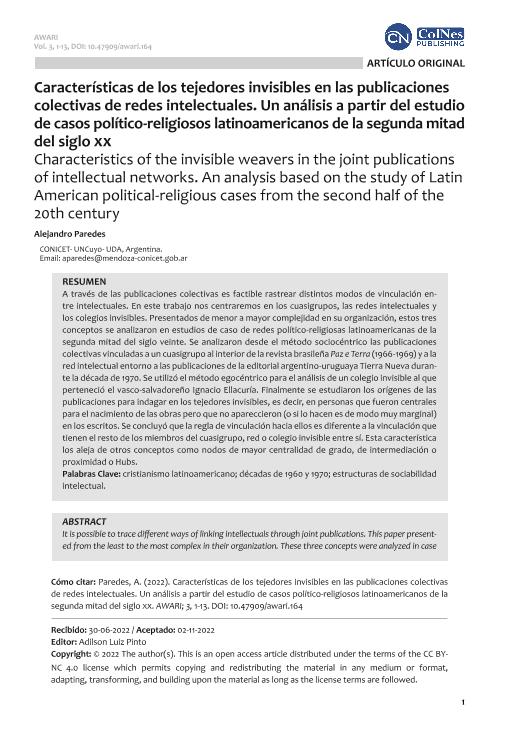Artículo
A través de las publicaciones colectivas es factible rastrear distintos modos de vinculación entre intelectuales. En este trabajo nos centraremos en los cuasigrupos, las redes intelectuales ylos colegios invisibles. Presentados de menor a mayor complejidad en su organización, estos tresconceptos se analizaron en estudios de caso de redes político-religiosas latinoamericanas de lasegunda mitad del siglo veinte. Se analizaron desde el método sociocéntrico las publicacionescolectivas vinculadas a un cuasigrupo al interior de la revista brasileña Paz e Terra (1966-1969) y a lared intelectual entorno a las publicaciones de la editorial argentino-uruguaya Tierra Nueva durante la década de 1970. Se utilizó el método egocéntrico para el análisis de un colegio invisible al queperteneció el vasco-salvadoreño Ignacio Ellacuría. Finalmente se estudiaron los orígenes de laspublicaciones para indagar en los tejedores invisibles, es decir, en personas que fueron centralespara el nacimiento de las obras pero que no apareccieron (o si lo hacen es de modo muy marginal)en los escritos. Se concluyó que la regla de vinculación hacia ellos es diferente a la vinculación quetienen el resto de los miembros del cuasigrupo, red o colegio invisible entre sí. Esta característicalos aleja de otros conceptos como nodos de mayor centralidad de grado, de intermediación oproximidad o Hubs. t is possible to trace different ways of linking intellectuals through joint publications. This paper present-ed from the least to the most complex in their organization. These three concepts were analyzed in case tudies of Latin American political-religious networks in the second half of the twentieth century. The joint publications linked to a quasi-group within the Brazilian journal Paz e Terra (1966-1969) and to the intellectual network around the publications of the Argentine-Uruguayan editorial Tierra Nueva during the 1970s were analyzed from the sociocentric method. The egocentric method was used to analyze an invisible school to which the Basque-Salvadoran Ignacio Ellacuría belonged. Finally, the origins of the pub-lications were studied to investigate the invisible weavers, that is, people who were central to the birth of the works but who did not appear (or if they do, it is in a very marginal way) in the writings. It was con-cluded that the linkage rule towards them is different from the linkage that the rest of the quasi-group, network, or invisible school have with each other. This characteristic distances them from other concepts, such as nodes with a higher degree of centrality, intermediation, proximity, or Hubs.
Características de las tejedoras invisibles en las publicaciones conjuntas de redes intelectuales. Un análisis a partir del estudio de casos político-religiosos latinoamericanos de la segunda mitad del siglo XX
Título:
Characteristics of the invisible weavers in the joint publications of intellectual networks. An analysis based on the study of Latin American political-religious cases from the second half of the 20th century
Fecha de publicación:
11/2022
Editorial:
CollNes
Revista:
Awari
e-ISSN:
2675-522X
Idioma:
Español
Tipo de recurso:
Artículo publicado
Clasificación temática:
Resumen
Archivos asociados
Licencia
Identificadores
Colecciones
Articulos(INCIHUSA)
Articulos de INST. DE CS. HUMANAS, SOC. Y AMBIENTALES
Articulos de INST. DE CS. HUMANAS, SOC. Y AMBIENTALES
Citación
Paredes, Héctor Alejandro; Características de las tejedoras invisibles en las publicaciones conjuntas de redes intelectuales. Un análisis a partir del estudio de casos político-religiosos latinoamericanos de la segunda mitad del siglo XX; CollNes; Awari; 3; 11-2022; 1-13
Compartir
Altmétricas




